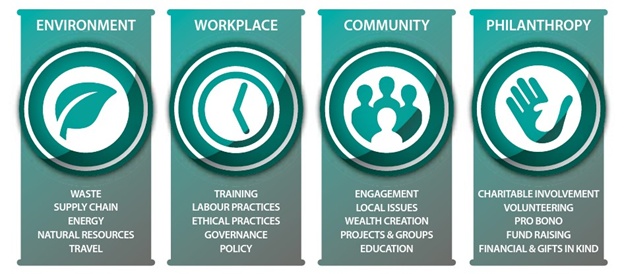The world has changed considerably in recent years, especially our attitude towards environmental and social responsibility. It’s not just the environmental issues that we are aware of but social issues such as ‘Black Lives Matter and ‘Me Too’. As human beings and individuals we care about these issues and increasingly, we want the businesses and organisations we work for to care as well. Richard Collins, CEO of CSR Accreditation addresses the practical steps PAs and EAs can take when navigating sustainability for environmental and social responsibility thanks to the unique position of influence they hold within an organisation, and the ability to co-ordinate across departments and drive through positive change.
How can businesses show that they are sustainable environmentally and socially?
Achieving an independent CSR accreditation from CSR-A, the only organisation in the UK delivering a global environmental social responsibility accreditation, is a powerful way to communicate positive actions to all audiences and stakeholders. The accreditation is a crucial component of every organisation’s promotional tool-kit and will increase your company’s competitive edge.
Environmental and social responsibility is a vital component for success and should be intrinsic to every business strategy, with the overall aim of achieving a positive impact on society and the environment. The accreditation will also provide a roadmap for planning future activity and the content for a non-financial disclosure report.
The four pillars of sustainability for environmental and social responsibility
The application provides a simple process where you record activity against the Four Pillars of sustainability, which are environment, workplace, community and philanthropy. Each pillar categorise a wide range of socially responsible activities that any organisation can engage in.
This category structure allows activity to be identified and defined and ultimately an accurate measurement of impacts and outcomes made.
Each pillar is designed to help you report on areas such as energy performance, recycling, staff engagement, health and well-being, community engagement and support for local and national charities.
Tool-kit to help you with the accreditation
This tool-kit is designed to provide the inspiration and information required to prepare you for the accreditation application.
TOOL 1 – Activity Lists
Use the CSR-A Four Pillars activity lists to identify efforts that you have made and activity that you are involved in. You may identify practices that are not shown on the Four Pillars activity lists. Include everything you consider relevant when carrying out your audit. Carry out a gap analysis to identify areas that need addressing and start a reporting process to record future activity and impacts.
TOOL 2 – Matrix Tables
The Four Pillars activity lists will prompt your thinking on what activities you are doing or not doing in relation to each matrix. You may also identify practices that are not shown by the Four Pillars activity lists. Please include anything you consider relevant. Fill in these matrix tables as step one of your audit. The four matrix questions are:
- What are we already doing?
- What are we doing that is not represented in the Four Pillars Activity lists?
- What could we be doing better?
- What else could we be doing?
TOOL 3 – Impact Audits
Identifying impacts, benchmarking and recording Using the Four Pillars matrix questions and the list of what your organisation is already doing you can select any activity and ask:
What internal impact has there been? For example, if your organisation has a recycling policy this will have an internal impact with regard to waste reduction and staff engagement, better education and awareness around plastics and future resources.
What external impact has there been? The external impact will be less landfill, environmental leadership and positive marketing and social media story telling.
What financial impact has there been? Reusing materials and products rather than buying new.
What PR impact is there likely to be? You can use the positive stories across all communication channels.
What key performance indicators are there?
The importance of understanding and measuring impact – Key performance indicators: KPIs are the critical (key) indicators of progress toward an intended result. KPIs provide a focus for strategic and operational improvement, create an analytical basis for decision making and help focus attention on what matters most.
TOOL 4 – Application Crib Sheets
These are provided for you to prepare and structure your CSR accreditation application information in a relevant way and to familiarise yourself with our Four Pillars and each of the five sub-categories of each Pillar.
In April 2021, the EU issued a proposal to strengthen sustainability reporting and assurance through the mandatory Corporate Sustainability Reporting Directive (CSRD). This is being adopted in 2024 and will fundamentally change the way companies of all sizes need to approach social responsibility / ESG reporting.
The great thing is that your organisation is probably doing a lot of positive things already reflected in these four pillars.
Each pillar is designed to help you impact report on areas such as energy performance, recycling, staff engagement, health and well-being, community engagement and support for local and national charities. It is a process in which you collate, measure and report on your organisation’s socially responsible activities. The framework ensures ESG compliance and aligns with the 17 SDG’s.
The future shape of business
We believe that business should be measured by both financial and social value. This framework will enable you to show return on social investment (ROSI) in terms of staff engagement/productivity, retention, recruitment, tendering, investment and reputation.
And as a final take-away, a reminder that CSR is a profit centre.
CSR Accreditation (CSR-A) is endorsed by Buckinghamshire New University and The Institute of Administrative Management (IAM)
You can download the toolkit for your organisation here.
Discover great sustainable and socially responsible businesses on our Recommended Supplier pages.











